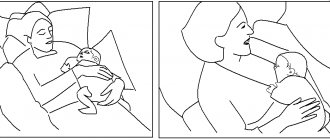When are enemas indicated?
Enemas in newborns are used if:
- The child is constipated and needs to clear the intestines of stagnant stool.
- Newborn requires medication administration
- Baby has food poisoning
Before giving your baby an enema for constipation, his mother should first completely review her daily menu and exclude foods that provoke this condition. This applies to situations where the child is breastfed.
If the cause of constipation is an adapted formula, provided that the child is bottle-fed, then after consulting with a pediatrician, the formula is replaced with another. In addition, problems with stool may occur due to improperly prepared mixture.
Why does the baby need help?
Babies do not know how to control their sphincter, that is, artificially, at their own request, delay the act of defecation. Therefore, if a baby has not gone to the toilet for more than a day, it is likely that there is a reason for constipation. Most often it lies in the following factors:
- disturbances of intestinal motility;
- improper nutrition of the mother (non-compliance with the nursing diet);
- psychological factor.
The accumulation of feces can lead to intestinal obstruction (especially if the baby does not release gases). In addition, the longer feces remain in the intestines, the harder they become, and the more painful subsequent bowel movements will be for the baby. That is why you should not leave the solution to the problem to chance - it is better to help the child cope with the situation as quickly as possible.
This is especially true if the baby becomes irritable, pushes, his face turns red, and begins to bend his legs more intensely. In this case, in all likelihood, constipation causes discomfort to the baby, but he still cannot communicate this in understandable language.
An enema will help restore peace and well-being to the baby, and also protect the body from intoxication.
Types of enemas
There are different types of enemas given to newly born babies.
A cleansing enema is used if a newborn has food poisoning, during constipation, or to administer medications through the intestines. The liquid used is ordinary warm water, which must first be boiled and cooled. Excessively hot water will burn the child, and cold water can lead to spasms.
A medicinal enema is performed on infants 30 minutes after the cleansing enema. Chamomile decoction is added to the enema water if the baby has flatulence, chloral hydrate solution for convulsions, sea buckthorn or rosehip oil, as well as antibiotics. Since during this procedure drugs must be absorbed into the intestinal mucosa, the temperature level should be in the range from 35 to 37 degrees.
Before performing an enema, you should consult your pediatrician.
The oil procedure is excellent for constipation in newborns. Vegetable oil is used for it (you can also use hemp or petroleum jelly). To carry out such therapeutic procedures, the oil is heated to body temperature (approximately 37 degrees) and injected into the anus using a standard syringe.
Read: Statistics of newborn names
It is best to carry out the procedure before the baby goes to bed, because it begins to act only after 9 or 10 hours.
A hypertensive enema is used to cleanse the intestines if the newborn has atonic constipation. The hypertonic solution should have a temperature between 25 and 30 degrees. After 30 minutes the expected effect will occur.
Parents should know that a siphon enema cannot be performed at home; only medical workers should perform it. In this case, a larger volume of water enters the child’s intestines than with a regular enema for cleansing.
It should be noted that this procedure has its disadvantages:
- Together with the enema, a small volume of liquid enters the newborn’s intestine, which has a destructive effect on the intestinal microflora that is not yet fully formed. She washes it away along with the feces.
- Water entering the intestines not only dilutes stool, but also helps toxins be absorbed.
- Regular enemas contribute to the occurrence of “lazy bowel” syndrome, when this organ ceases to perform its functions normally.
If a mother wants her child to be healthy, she should not overuse such procedures. It is best to give an enema to a newborn only in extreme cases.
What is important to remember?
An enema is a truly effective method of combating constipation. But in addition to how to properly give an enema to a baby, it is not superfluous to remember that it should not be done often. Abuse of this method will lead to relaxation of the intestines - it simply will not want to “work” on its own anymore.
An enema is done only in extreme, even emergency cases, when it is necessary to help the child urgently. If constipation is expressed only in a failure of the bowel movement, and the baby does not show concern, you can help him with other methods: a light tummy massage, laying him out on a warm diaper, a warm relaxing bath and dill water will do the trick. This one will take a little more time, but such measures will be more gentle on the body.
How to give an enema correctly?
Mothers should remember that an enema can be given to a child only if he shows anxiety, he has not had a bowel movement for several days, his stomach is tight and hard, and he constantly kicks his legs. In order to perform an enema, you must choose a syringe with a soft tip. Before use, it must be boiled and cooled.
A newborn can be given warm water (boiled and cooled) or a chamomile decoction diluted in it. Instead of such liquid, you can take a little vegetable oil. Chamomile helps a lot if the baby has increased gas production, and the oil gently envelops the feces and removes them from the intestines without injuring it. Mom should remember that the temperature for an enema solution carried out at home should not be higher than 30 degrees.
When carrying out the procedure, you should follow the advice of specialists
Before starting this procedure, the mother needs to wash her hands well with soap, lay down an oilcloth, and put a diaper on top of it. Then the baby should be placed on his back or left side. The baby's legs should be pressed to the stomach. The syringe needs to be removed from the water in which it was boiled and checked what its temperature is. In addition, be sure to pour all the boiling water out of it.
Read: Reviews of Magna B6 are positive
After this, all the air is removed from the syringe and filled with the prepared solution, gradually making it easier to press. In order for the enema to be administered better, its tip is lubricated with cream. The nozzle of the syringe is inserted into the anus with gentle movements of approximately 1 or 2 cm (no more) and the solution is slowly injected.
Then you need to pull out the syringe and cover the baby’s anus with the opposite hand. Thanks to this, the liquid will soften hard feces and facilitate their release. After about half a minute, mom can remove her hand.
In addition, you need to consider that:
- As a filler for the syringe, use only liquids recommended by a pediatrician in a medical institution
- The temperature of the solution should be suitable for the type of enema
- After such a procedure, the baby should lie quietly for several minutes.
The mother needs to know that the newborn must be given an enema according to all the rules, otherwise such a procedure will not be beneficial.
In the video - tips for parents:
31 Dec 2021 Yuki 477
Share this post
We recommend reading along with this article
- How to do an enema at home for pregnant women and children?
- How to give an enema to a baby: features of the procedure
- Do they do an enema before childbirth - all the pros and cons...
- Rectal suppositories - features of the drug for children
- Similak Premium: composition, feeding schedule, reviews
- Why doesn't a child poop, reasons and when to start panicking?
- Balanced diet and proper nutrition during breastfeeding
- Analgin and papaverine - what is the name of the drug
- Sea buckthorn oil for a runny nose - tips and methods of use
Discussion: there is 1 comment
- Nika:
01/09/2017 at 00:03The opinions of doctors in this case vary, and everyone says something different. Of course, enemas definitely cannot be abused. But sometimes you just can’t do without it. Therefore, you need to choose the lesser of two evils.
Answer
Recommendations
Before giving an enema, you can try other methods of stimulation.
- Massage of the abdominal area. This method involves stroking the baby's belly clockwise with warm hands treated with cosmetic oil an hour after eating. You need to apply a little pressure on your stomach. After the massage, the child should lie on his stomach. This massage is recommended to be performed frequently to ensure proper functioning of the gastrointestinal tract.
- Warm bath. This procedure will help relax the baby.
- Dill water. If the drink is prepared correctly, it normalizes intestinal function. To prepare, you need to brew several sprigs of dried herbs in a glass of water. The child should be given 2 teaspoons of decoction.
- Warm diaper. If you put a warm diaper on your baby's belly and then pick him up, your intestinal function will be activated. The procedure should be performed several times.
- Stimulating the colon with a cotton swab. The stick must be lubricated with Vaseline and inserted into the anus to a depth of half a centimeter and gently twist slowly.
An enema given at home for a baby is a therapeutic measure that must be carried out when other, more gentle methods of stimulating the process of defecation do not work. Under no circumstances should this procedure be performed frequently, so as not to provoke the appearance of pathological processes in the intestines.
While a newborn or infant is being breastfed, you don’t have to worry too much about bowel function. If the child is calm and gaining weight well, then when breastfeeding, bowel movements can be from 1 to 10 times a day (See how many times a newborn poops). But if a child cannot go to the toilet for a long time, then you need to take some measures, and all mothers should know how to properly give an enema to their infant so as not to harm it.
Why does chamomile help with constipation?
Chamomile preparations are used as part of complex therapy to combat gastrointestinal diseases if there are problems with bowel movements. It has a beneficial effect on overall health and helps combat gastrointestinal problems.
The plant contains many substances that have a positive effect on the digestive organs.
The active components contained in chamomile act on the body as follows:
- Pectin – helps remove toxins without destroying natural microflora. Provides stimulation of intestinal motility. The enveloping properties of pectin help restore the mucous membrane.
- Thanks to apigenin, the development of inflammation and allergies is suppressed. Harmful microorganisms are eliminated.
- Tannins improve the balance of bacteria and prevent fermentation.
- Carotene – participates in the activation of metabolic processes.
- Essential oils - work to soften stool. Helps ease the process of defecation.
- Glycine – relaxes smooth muscles, relieves spasms.
- Ascorbic acid – improves immunity, the functioning of the digestive system, accelerates bile excretion.
Chamomile provides a gentle effect on the body, preventing constipation. There is no negative effect on the digestive organs.
For therapeutic purposes, dried inflorescences are used, which can be purchased at a pharmacy or prepared independently.
Indications and contraindications for use
Doing an enema with chamomile decoction or infusion is recommended for gynecological diseases and pathologies of the gastrointestinal tract.
- symptoms of hemorrhoids;
- constipation;
- flatulence, colic;
- diseases of the rectum;
- diarrhea;
- intestinal spasm.
If you prepare and use the medicine correctly, you can quickly eliminate unpleasant clinical manifestations of diseases, cleanse the intestines of pathogenic microorganisms, including from areas with micro-tears, regenerate tissue, and reduce hemorrhoidal tumors.
For men, chamomile infusion is perfect for the treatment of prostatitis. The comfortable temperature of the liquid is +18…+25 ⁰С, however, in case of inflammation in the prostate gland, it is recommended to do a hot enema so that the temperature of the infusion reaches +40…+45 ⁰С.
The effectiveness of the hot procedure is due to the fact that with prostatitis, congestion develops in the pelvic area, which can be eliminated by high temperature, which increases blood circulation and improves the delivery of nutrients to the prostate.
In addition to chamomile, hot procedures for inflammation of the prostate are done with components such as iodine, milk, sea buckthorn oil, Dimexide.
Chamomile enema brings not only benefits, but also harm in certain cases.
- In case of inflammation of the intestines in the acute phase, in particular of the rectum.
- For rectal prolapse or severe bleeding during the development of hemorrhoids.
- In case of acute pain syndrome or pathology that requires urgent surgical intervention.
- For chronic gastrointestinal diseases.
- In the presence of a tumor-like neoplasm (benign or malignant) in the rectal area.
In such cases, the doctor selects another treatment.
Use chamomile decoction and infusion with caution when performing an enema during pregnancy and breastfeeding. During these periods, the risk of complications increases.
The procedure helps with bloating or hemorrhoids.
- congenital tumor-like neoplasm or growth in any area of the gastrointestinal tract;
- the presence of a crack or microcrack in the anus;
- inflammatory process in the anus;
- rectal prolapse;
- development of dysbacteriosis;
- diseases requiring emergency surgical intervention;
- bleeding from the anus;
- allergic reactions.
It is prohibited to perform such an enema on children and adults with chronic constipation.
How to prepare chamomile
The procurement of plant raw materials is carried out far from the city, away from roads and industrial enterprises. When harvesting chamomile, the open heads of the inflorescences are collected. The best period for this is May and June, when active flowering begins.
It is better to dry chamomile under a canopy, in a well-ventilated place, hidden from the direct influence of the sun. For drying, the flowers are spread on the surface in a thin layer; they need to be tossed from time to time. The drying process takes a week.
The readiness of the herb can be determined by the fact that it will be rubbed with your fingers to a powder state. It will be suitable for use throughout the year.
For storage, it is scattered in linen bags or placed in a cardboard box.
Possible complications
- Damage to the rectal mucosa due to improper installation of the enema. Due to the fact that the intestinal walls have a delicate mucous membrane, trauma can cause the formation of painful erosions. The risk of developing inflammation cannot be excluded.
- Frequent procedures can cause intestinal dysbiosis, because beneficial microflora is washed out. It is recommended to carry out cleansing manipulation no more than 2 times a year, and therapeutic manipulation – no more than once every 2 days.
- Frequent use of enemas leads to disruption of intestinal function. Due to a malfunction in peristalsis, a person develops chronic constipation.
Do not neglect contraindications. Otherwise, you can cause an exacerbation of existing intestinal pathologies: the appearance of nausea and vomiting syndrome, pain symptoms in the epigastric region, general malaise, and internal bleeding.
Sometimes headache and dizziness occur.
These clinical manifestations indicate intolerance by the body to the components of the medicinal solution. It is not recommended to continue therapy, but you should consult a doctor to adjust the treatment.
It is not advisable to use traditional medicine as the only method of treating diseases.
Such remedies do not help eliminate the main cause of the pathology, but stop its clinical manifestations. This also applies to chamomile enema.
In any case, treatment must be comprehensive. You should not engage in therapy on your own, but rather consult a doctor.
How to give an enema to a newborn at home for constipation: how often can you do it?
In infants, the digestive system is not fully developed, so many of them have intestinal dysfunction.
Sometimes, to resolve the current situation, an enema for newborns is required. Many people wonder: is an enema always necessary for newborns, and is it possible to do without it? With constipation, the child is worried and often cries
Note.
An enema is a procedure in which water, drugs, or other substances are introduced into the body (into the rectum through the anus or into the colon through intestinal tubes or using an enema tip). Manipulations to cleanse the intestines can be carried out not only in a hospital setting. Therefore, many people want to know how to give a baby an enema correctly.
Etiology of constipation
Constipation in infants can be caused by various factors:
- infection;
- lack of water (liquid) in the baby’s diet;
- poor nutrition of the mother;
- inflammatory reactions in the gastrointestinal canal;
- allergies to certain foods;
- Hirschsprung's disease;
- transition from breastfeeding to artificial feeding;
- deficiency of breast milk;
- changing milk formula;
- systematic stress;
- dehydration of the body;
- taking medications.
Clinical examination of the baby
When is an enema needed?
How to give an enema to a small child under one year old
A child under 3 months should poop at least 2-4 times a day. When a baby does not have stool for more than 2 days, this may indicate that he has constipation. Sometimes it happens that a baby completely absorbs mother's milk, so he may not have a bowel movement for 3-5 days.
If a baby does not have bowel movements, this is not a reason to panic. If the toddler develops well, is active, gains weight well and sleeps normally, then rare bowel movements are quite normal.
We can talk about intestinal dysfunction only when, in addition to constipation, the baby is diagnosed with other signs: lack of appetite, tearfulness, apathy, flatulence, abdominal pain.
In this case, it is very important to pay attention to the condition of the stool. In infants, they should have a mushy shape with a yellowish tint.
With constipation, stool is dark in color, hard, with a pronounced odor.
You can suspect the development of constipation in a baby based on the following signs:
- the child constantly cries and refuses food;
- when trying to poop, he grunts and strains a lot;
- hard feces;
- When palpating the abdomen, the child feels discomfort.
When constipated, children tuck their legs towards their tummy
Indications and contraindications
In fact, there are not many indications for giving an enema to young children, the main ones being the following:
- spastic colitis;
- constipation in newborns;
- digestive dysfunction, which leads to increased gas formation;
- intoxication of the body;
- inflammatory reactions in the intestines (microenemas with antibiotics and other antiseptic substances are prescribed);
- feverish condition.
An enema is not given in the following cases:
- suspicion of surgical pathology (intestinal volvulus, appendicitis, internal bleeding, pinched hernia, paraproctitis, rectal and anal fissures);
- the presence of inflammatory processes in the perineum, rectum and anus;
- rectal prolapse;
- congenital neoplasms in the gastrointestinal tract;
- early postoperative period.
Important! The temperature of the liquid for a cleansing enema should be from 26 to 37 °C. The attending physician will tell you how many procedures you need to undergo.
What types of enemas are there?
Microlax for newborns - how to use an enema for infants
Depending on the goals and technique of implementation, the following types of enemas are distinguished:
- Diagnostic. During this manipulation, contrast compounds are introduced into the child’s intestinal cavity for diagnostic purposes. Immediately after the procedure, an x-ray is taken.
- Cleansing. It does not require any special skills, so it can be done even at home. Most often, clean boiled water without any additives is used to carry out the procedure.
- Nutritious. It is performed to introduce some medications into the intestines. These can be nutrient solutions in case of impairment or inability to eat. A medicinal enema is given only after 20-30 minutes. after cleansing the intestines of feces.
- Oily. To prepare an oil enema, you can use different types of vegetable oils. The liquid temperature should be between 30 and 37 °C. A local pediatrician can tell you how to give an enema to a newborn at home.
- Siphon. This type of enemas is prescribed by a doctor only in cases of severe poisoning. It is performed in a medical facility under the supervision of medical staff.
Cleansing enema for a child
For unprepared parents, the procedure of enema for infants is always something creepy and scary. In reality there is nothing complicated about it. It is important to carry out the manipulation with maximum caution and calm.
At home, cleansing enemas can be performed in the absence of anxiety in the child and disturbances in his well-being. It is almost impossible to give an enema to a baby without outside help; it is better that 2-3 adults participate in this process.
A single enema does not always help. There may be a situation in which the procedure will need to be repeated. The main thing is to remember that the break between enema manipulations should be at least 6 hours.
Step-by-step instruction
Vaseline oil and ointment for newborns
Before performing the procedure, you need to make sure you have all the necessary attributes:
- baby soap;
- cotton pads;
- clean oilcloth with a diaper;
- syringe with a rubber or silicone tip (volume no more than 60 ml);
- warm boiled water;
- Vaseline or cream.
Additional Information. All instruments and solutions used for performing an enema must be sterile. Before use, the pear is boiled for 25-30 minutes. Hands are washed thoroughly with soap. The volume of the enema should correspond to the age of the child.
The data is presented in the table.
Enema volumes according to age
Amount of liquid, ml Child's age
| 10-25 | 1-2 months |
| 30-60 | 2-4 months |
| 70-100 | 6-9 months |
| 120-170 | 9-12 months |
| 200-250 | 12-24 months |
| 270-300 | 2-5 years |
| 350-400 | 5-9 years |
| 400-500 | over 10 years old |
Cleansing enema for constipation for newborns
In order to properly administer an enema to a baby, you need to perform the following steps:
- Measure the temperature of the enema solution.
- Remove air from the pear.
- Place the child on his left side, move his legs towards his stomach.
- Lubricate the anus and the tip of the bulb generously with Vaseline.
- Spread the buttocks apart with your fingers, then carefully insert the tip into the anus.
- The contents of the syringe must be released slowly.
- After introducing the solution, the tip of the bulb is smoothly pulled out of the rectum.
- The child’s buttocks are squeezed with your fingers and held for several minutes.
An enema can be given to a baby no more than once a week. Often after the procedure there is quite a lot of stool, so you need to prepare for this process in advance. You need to have the appropriate items on hand. The most convenient to use and safest for children are ready-made Microlax microenemas, which can be purchased in pharmacies.
Note.
Microlax contains sodium lauryl sulfoacetate, sodium citrate, sorbitol solution, as well as excipients (sorbic acid, glycerin, water). Sodium citrate displaces water associated with feces, sorbitol ensures the flow of water into the large intestine, and sodium lauryl sulfoacetate helps dilute the intestinal contents.
To treat constipation in newborns, Microlax can be used from the first days of life. For infants, the tip is inserted only half the length, the contents of the tube are inserted completely.
After a microenema, doctors recommend giving the baby a tummy massage in a circular motion in a clockwise direction.
The question of how often Microlax enemas can be given to a newborn should be decided by the treating pediatrician.
Advice. You should not engage in self-diagnosis and self-medication. If you suspect intestinal diseases, you should consult a doctor.
Composition of an enema solution for a baby
To cleanse the intestines, doctors recommend using the following enemas:
- kitchen salt (1/2 teaspoon of salt per 200 ml of water);
- chamomile infusion (1 tablespoon pour 200 ml of boiling water);
- baby soap (a small piece of soap per glass);
- baking soda (1 teaspoon of baking soda per glass);
- olive oil (1 teaspoon of oil per 500 ml of water).
How often can you do an enema?
Experts recommend resorting to this procedure as rarely as possible and only in cases where alternative solutions are ineffective. It is best to carry out manipulation at least once a month.
Carrying out the procedure frequently removes beneficial bacteria from the body and can lead to injuries to the delicate mucosa. With prolonged use of enemas, it is difficult for the child’s body to cope with the excretion of feces: the walls of the intestines relax, feces move poorly towards exit, and constipation develops.
Microlax is the best remedy for constipation in children
How not to do an enema
Many parents tend to make mistakes when they first try to give an enema. An incorrect algorithm of actions can significantly reduce the effectiveness of the procedure. Some of the most common errors include the following:
- unwashed hands;
- administering fluid too quickly;
- use of cold or hot water;
- air entering the intestines;
- discrepancy between the volume of fluid and the age norm.
Preventing constipation
It is much easier to prevent any problem than to treat it. To prevent constipation, you should adhere to the following recommendations:
- normalize the diet of mother and child;
- provide the optimal amount of water in the baby’s diet;
- before feeding the baby for 5 minutes. turn him over on his tummy;
- Do regular exercises with your child;
- massage the tummy;
- follow all doctor's recommendations;
- prevent the baby from overheating;
- If problems arise, contact your pediatrician immediately.
Even if you know how to give an enema to a baby, you should not forget about contraindications and possible side effects. If digestive problems do not disappear after performing an enema, you should make an appointment with your doctor. You cannot continue treatment with enemas on your own.
Source: https://kpoxa.info/zdorovie-pitanie/klizma-dlya-novorozhdennyx.html









